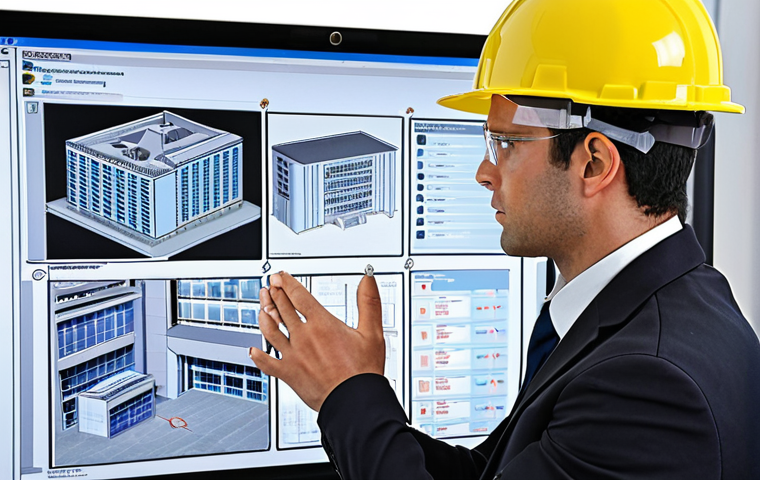Considering a career in fire safety? It’s far more than just extinguishing flames; it’s about meticulous prevention, leveraging advanced technology, and ultimately, safeguarding countless lives and valuable assets.
I remember feeling a bit overwhelmed by the sheer scope and the possibilities within this field when I first started, and frankly, the salary potential was a major question mark for me too.
But having navigated this dynamic path for years, I’ve seen firsthand how incredibly vital and rewarding this profession truly is, especially as our cities grow and technology evolves.
The demand for skilled Fire Safety Engineers isn’t just consistent, it’s escalating rapidly. With the rise of smart buildings, complex industrial landscapes, and evolving regulatory frameworks driven by climate change and global safety standards, our expertise is more crucial than ever.
We’re at the forefront of integrating AI-powered detection systems, IoT sensors for real-time risk assessment, and innovative suppression technologies.
This isn’t just a job; it’s a strategic role impacting public safety and infrastructure worldwide, offering a surprisingly stable and lucrative choice for those with the right blend of technical acumen and a passion for protection.
Let’s delve deeper into what a career in fire safety management truly entails, from compensation to long-term growth.
Beyond the Blueprint: The Core Responsibilities of a Fire Safety Engineer

The role of a fire safety engineer is incredibly dynamic, stretching far beyond what many initially imagine. When I first stepped into this field, I envisioned mostly site inspections and code checks.
While those are definitely part of it, the reality is a much richer tapestry of strategic planning, innovative problem-solving, and continuous learning.
We’re not just looking at existing structures; we’re often involved from the ground up, influencing the very design of a building to ensure inherent safety.
This proactive approach is what truly excites me – the chance to prevent a disaster before it ever has a chance to unfold. It feels immensely rewarding to know that my daily work contributes directly to people’s safety, whether they’re in a skyscraper, a hospital, or a sports arena.
Every decision, from the type of sprinkler system to the evacuation routes, is weighed with the highest stakes in mind.
From Concept to Construction: Design and Code Compliance
One of our primary responsibilities, and something I personally find deeply engaging, is the review and approval of architectural and engineering plans.
We’re the gatekeepers, ensuring that every proposed design adheres to stringent fire safety codes and regulations, be it the International Building Code (IBC), NFPA standards, or local amendments.
This isn’t just about ticking boxes; it’s about foreseeing how fire might behave in a complex structure and designing systems that mitigate that risk.
I remember working on a massive data center project where the sheer volume of sensitive equipment and the need for uninterrupted power posed unique challenges.
We had to innovate, looking at specialized suppression systems and compartmentation strategies that went beyond the standard playbook. It’s a constant puzzle, where you’re trying to balance functionality, aesthetics, and uncompromising safety.
This phase is critical because mistakes made here are exponentially more expensive and dangerous to correct later.
Risk Assessment and Mitigation: Proactive Protection
Another crucial aspect, and perhaps the most complex, is conducting thorough fire risk assessments. This involves analyzing a building’s occupancy, its materials, the potential ignition sources, and the human behavior in an emergency.
From my experience, this is where the detective work truly begins. You’re not just looking for obvious hazards; you’re thinking about the “what ifs.” What if a power surge occurs?
What if a specific material reacts unexpectedly to heat? We then develop comprehensive strategies to mitigate identified risks, which might include recommending advanced fire suppression systems, specifying fire-resistant materials, or designing robust emergency response plans.
I once consulted for an old manufacturing plant with outdated systems, and the challenge was immense, requiring a phased approach to bring it up to modern standards without disrupting operations.
It was a painstaking process, but seeing the comprehensive safety plan come together, knowing the workers were now truly protected, was a profound feeling of accomplishment.
Unpacking the Paycheck: Factors Influencing a Fire Safety Engineer’s Salary
Let’s be frank: while passion drives us, a comfortable living allows us to pursue that passion without undue financial stress. When I first started researching this career path, the salary figures were a significant point of interest, and I quickly learned that “fire safety engineer salary” isn’t a single, fixed number.
It’s a spectrum, influenced by a myriad of factors, much like any specialized engineering discipline. What I’ve observed over the years is a steady upward trend, especially for those who gain specialized knowledge or take on leadership roles.
It’s a field where your value truly compounds with experience and the unique problems you learn to solve. The demand far outweighs the supply of truly skilled professionals, which naturally drives compensation upwards.
Experience Level and Geographic Location: The Twin Pillars of Earning Potential
The most apparent factors influencing a fire safety engineer’s salary are their level of experience and where they choose to work. Entry-level positions, typically for those fresh out of university, will naturally start lower as you gain practical knowledge and complete necessary certifications.
However, even these starting salaries are quite competitive. As you accumulate years of experience, say 5 to 10 years, and demonstrate a track record of successful project management and problem-solving, your earning potential increases significantly.
Beyond 10-15 years, especially if you move into senior management, consultancy, or specialized roles, the figures can become very attractive. Location also plays a massive role.
Major metropolitan areas with high construction rates and complex infrastructure, like New York, Los Angeles, or London, generally offer higher salaries to offset the higher cost of living and the greater complexity of projects.
Conversely, rural areas might have fewer opportunities or offer slightly lower compensation.
Specialization, Industry, and Certifications: Boosting Your Value
Beyond experience and location, your specific area of expertise, the industry you work in, and your professional certifications can dramatically impact your salary.
For instance, an engineer specializing in industrial fire protection for petrochemical plants, which involves extremely high-risk environments, will likely command a higher salary than someone focused solely on commercial building codes, though both are vital roles.
Similarly, working for a major corporation with complex global assets, or a specialized consulting firm, often offers better compensation packages than working for a small, local government agency.
Furthermore, obtaining professional certifications like a Professional Engineer (PE) license in the United States, or becoming a Chartered Engineer (CEng) in the UK, not only enhances your credibility and authority but also your earning capacity.
These certifications signify a high level of competence and commitment to the profession, making you a more valuable asset to any employer.
| Experience Level | Average Annual Salary (USD) | Key Responsibilities & Impact on Salary |
|---|---|---|
| Entry-Level (0-2 years) | $60,000 – $75,000 | Assisting senior engineers, learning codes, basic plan reviews. Salary influenced by academic background and initial certifications. |
| Mid-Career (3-7 years) | $75,000 – $100,000 | Leading smaller projects, conducting independent assessments, client interaction. Specialization begins to impact earnings. |
| Experienced (8-15 years) | $100,000 – $140,000+ | Managing complex projects, mentoring, developing innovative solutions. PE license and specific industry expertise highly valued. |
| Senior/Consultant (15+ years) | $140,000 – $200,000+ | Strategic leadership, expert witness testimony, business development. Highest earners often run their own firms or hold executive roles. |
The Skillset Spark: What You Really Need to Thrive in Fire Safety
When I look back at my journey, I realize that technical prowess, while foundational, is only one piece of the puzzle. To truly excel as a fire safety engineer, you need a blend of analytical thinking, a keen eye for detail, and surprisingly robust communication skills.
I’ve seen incredibly smart engineers struggle because they couldn’t articulate complex ideas to non-technical stakeholders, or they lacked the finesse to negotiate changes with a demanding client.
This profession isn’t just about numbers and codes; it’s about people – understanding their needs, ensuring their safety, and sometimes, convincing them to invest in necessary safeguards.
The ability to translate technical jargon into understandable language is a superpower in this field, and it’s something I continuously work on.
Mastering the Codes and Technologies: The Technical Core
At the heart of fire safety engineering is an unwavering grasp of building codes, fire codes, and national/international standards like NFPA (National Fire Protection Association) standards.
This is the bedrock. You need to know them inside out, understand their intent, and be able to apply them rigorously. Beyond codes, proficiency in fire modeling software (like FDS – Fire Dynamics Simulator), CAD programs, and hazard analysis tools is absolutely essential.
These tools allow us to simulate fire growth, smoke movement, and evacuation scenarios, providing invaluable insights into a building’s performance during a fire.
I remember my early days, painstakingly learning each software package, and frankly, some of it felt like learning a new language. But the payoff is immense; it allows you to truly visualize and predict outcomes, making your recommendations evidence-based and incredibly powerful.
Continuous learning in this area is non-negotiable, as technology and regulations are constantly evolving.
Beyond the Book: Communication, Problem-Solving, and Ethics
While technical skills open doors, it’s the soft skills that truly define a successful fire safety engineer. Effective communication is paramount – whether you’re explaining a design flaw to an architect, presenting a risk assessment to a client, or testifying as an expert witness.
You need to be clear, concise, and persuasive. Problem-solving is another non-negotiable skill; every project presents unique challenges, and you must be able to think critically, analyze complex situations, and devise innovative solutions.
I’ve faced situations where standard solutions simply wouldn’t work, forcing me to think outside the box and consult with diverse experts. Finally, an unshakeable ethical compass is vital.
Our work directly impacts lives, and there’s an immense responsibility to act with integrity, always prioritizing safety over cost or convenience. I’ve had to make tough calls, advocating for a safer, albeit more expensive, solution, and standing firm on those principles is what earns trust and respect in this profession.
Climbing the Ladder: Career Progression and Specialization Pathways
One of the most appealing aspects of a career in fire safety engineering, from my personal vantage point, is the sheer breadth of opportunities for growth and specialization.
It’s not a stagnant field; instead, it offers multiple avenues for professional development, allowing you to tailor your career path to your specific interests and strengths.
I’ve seen colleagues start in general consulting and then transition into niche areas like high-rise building design, industrial processing plants, or even forensic fire investigation.
This adaptability and the chance to continually redefine your expertise is truly motivating and prevents any sense of professional stagnation. The journey from a junior engineer to a recognized authority is challenging but incredibly rewarding.
From Junior Engineer to Project Lead: Standard Progression
The typical career trajectory often begins as a junior fire safety engineer, working under the guidance of senior professionals. During this phase, you absorb knowledge, learn the practical application of codes, and assist with calculations, reports, and site visits.
This is where the foundational understanding is built, and honestly, every mistake I made in those early days taught me invaluable lessons. With a few years of experience, you progress to an intermediate or project engineer role, where you start managing smaller projects independently, interacting directly with clients, and taking on more responsibility for design and compliance.
The next step is often a senior engineer or project manager, leading larger, more complex projects, overseeing junior staff, and making critical design decisions.
This progression isn’t just about technical skill; it’s also about developing leadership qualities and a robust understanding of project economics and client relations.
Diving Deep: Niche Specializations and Expert Roles
Beyond the general progression, the field truly opens up into fascinating specializations. For example, you could become an expert in performance-based design, where instead of strictly adhering to prescriptive codes, you use advanced modeling and analysis to prove that a building’s design achieves equivalent or superior fire safety.
This is a highly sought-after skill for complex, iconic structures. Another path is industrial fire protection, focusing on high-hazard environments like chemical plants, oil refineries, or power generation facilities, which require an intimate understanding of process safety and unique fire risks.
Furthermore, fire investigation and forensics is a distinct specialization where engineers determine the origin and cause of fires, often working with legal teams.
The beauty is that you can build a highly specialized and incredibly valuable profile over time, becoming one of the go-to experts in your chosen niche, a position that commands significant respect and, of course, higher compensation.
Navigating the Inferno: Challenges and Rewards in Fire Safety Engineering
Like any demanding profession, fire safety engineering comes with its own unique set of challenges, often requiring a cool head under pressure and a significant amount of resilience.
But for every challenge, I’ve found there’s an even greater reward, a sense of purpose that few other careers can offer. There are days when the regulations seem overwhelming, or client demands push the boundaries of what feels safe, and those are the moments when your integrity and professional judgment are truly tested.
Yet, it’s precisely in navigating these complexities that the profound satisfaction of the job emerges. It’s a field that constantly asks you to be at your best, to learn, and to adapt.
Overcoming Complexities: Regulations, Costs, and Unforeseen Hazards
One of the most persistent challenges is navigating the intricate web of ever-evolving codes and regulations. What was permissible last year might be updated this year, and keeping abreast of all changes across different jurisdictions is a continuous task.
It can sometimes feel like trying to hit a moving target, especially on projects that span multiple regions or countries. Another common hurdle is balancing safety requirements with budget constraints.
Clients naturally want the most cost-effective solutions, but our paramount responsibility is safety. This often leads to delicate negotiations where you must firmly and convincingly articulate the necessity of certain safety measures, demonstrating their long-term value and life-saving potential.
I’ve been in countless meetings where I had to hold my ground, explaining why a particular system wasn’t just “nice to have” but absolutely critical for the safety of occupants.
Then there’s the challenge of unforeseen hazards – every building, every industrial process, every human element presents a unique set of risks that require creative and robust solutions.
The Ultimate Reward: Safeguarding Lives and Making a Tangible Difference
Despite the complexities, the rewards of being a fire safety engineer are, in my personal opinion, immeasurable. The most profound satisfaction comes from knowing that your work directly contributes to safeguarding lives and protecting valuable assets.
When you see a building you designed or retrofitted standing tall and safe, or hear about a fire incident where the systems you specified performed exactly as intended, that feeling of accomplishment is unparalleled.
It’s a tangible impact on society, a direct contribution to public safety that few professions can claim. Furthermore, the collaborative nature of the work, engaging with architects, civil engineers, emergency services, and building owners, means you’re constantly learning and expanding your network.
The intellectual challenge of problem-solving, combined with the ethical responsibility, makes this a profoundly engaging and personally fulfilling career.
It’s more than just a job; it’s a vital public service, and that’s something I truly value.
The Future is Bright (and Safe): Emerging Technologies and Industry Trends
The field of fire safety engineering is far from static; in fact, it’s currently undergoing a fascinating transformation driven by technological advancements and evolving societal needs.
From my perspective, this makes it an incredibly exciting time to be in the profession. We’re moving beyond traditional detection and suppression methods into an era where predictive analytics, smart materials, and integrated systems are becoming the norm.
This isn’t just about efficiency; it’s about creating safer, more resilient environments than ever before. Embracing these innovations is not just a trend; it’s essential for staying relevant and effective in a rapidly changing world.
The thought of what’s coming next genuinely invigorates me and reinforces the decision I made to pursue this career.
Smart Buildings and IoT Integration: Predictive Fire Safety
One of the most significant trends I’m witnessing is the integration of Internet of Things (IoT) devices and smart building technologies into fire safety systems.
Imagine sensors that don’t just detect smoke, but also monitor ambient temperatures, humidity, airflow, and even occupancy levels in real-time, feeding this data into a central analytical platform.
This allows for far more granular and predictive fire risk assessment. We’re talking about systems that can identify potential ignition sources before a fire even starts, or dynamically adjust ventilation and evacuation routes based on the real-time spread of smoke.
I’ve been involved in preliminary discussions for projects where AI algorithms are being trained to recognize unusual patterns in sensor data, potentially identifying fire risks far earlier than conventional alarms.
This shift from reactive to proactive and even predictive fire safety is revolutionary, promising a level of protection previously unimaginable.
Sustainability and Resilience: Green Building and Climate Impact
Another major trend is the increasing emphasis on sustainability and resilience in building design, which profoundly impacts fire safety. Green buildings, with their focus on energy efficiency and recycled materials, present unique fire safety challenges and opportunities.
For instance, new insulation materials or solar panel installations might require different fire suppression strategies or access considerations for firefighters.
Fire safety engineers are increasingly vital in ensuring that sustainable designs don’t inadvertently compromise safety, and conversely, that fire safety measures are themselves sustainable.
Furthermore, the growing awareness of climate change is driving a push for more resilient infrastructure that can withstand not just fire, but also extreme weather events.
This means designing systems that are robust and capable of performing under adverse conditions, ensuring that buildings remain safe even when external factors are compromised.
It’s a holistic approach to safety that I find incredibly compelling and challenging in equal measure.
Is Fire Safety Your Calling? Making the Leap into a Vital Profession
After years in this field, I can genuinely say that becoming a fire safety engineer was one of the best decisions I’ve ever made. It’s a career that combines intellectual rigor with a profound sense of purpose, offering consistent challenges and immense satisfaction.
If you’re someone who thrives on problem-solving, has a keen eye for detail, and feels a deep-seated desire to contribute positively to society, then this profession might just be your calling.
The journey isn’t always easy – it requires continuous learning, adaptability, and the courage to advocate for what’s right – but the rewards, both personal and professional, are truly worth the effort.
It’s a privilege to be part of a community dedicated to keeping people safe, and knowing my work makes a tangible difference every single day is an incredibly powerful motivator.
Evaluating Your Passion: Technical Acumen Meets Social Impact
Before diving headfirst, take some time to genuinely assess if this field aligns with your innate interests and strengths. Do you enjoy dissecting complex problems and piecing together solutions?
Are you detail-oriented, capable of poring over technical drawings and regulations? Beyond the technical side, consider your desire for social impact.
This isn’t just about engineering; it’s about public safety. Do you feel a responsibility towards safeguarding others? From my own experience, the most successful fire safety engineers are those who possess both strong analytical skills and a genuine concern for human well-being.
It’s a career that demands your intellect but rewards your compassion, creating a unique blend that is profoundly satisfying. If the thought of preventing disasters and contributing to the resilience of our communities excites you, then you’re already on the right track.
Navigating the Path: Education, Certifications, and Networking
Once you’ve decided this is the path for you, focus on building a strong foundation. A degree in fire protection engineering, civil engineering, mechanical engineering, or a related field is typically the first step.
Look for programs with strong accreditation and opportunities for internships, as practical experience is invaluable. After graduation, actively pursue professional certifications, such as the Professional Engineer (PE) license in the U.S.
or similar accreditations in your region. These credentials not only validate your expertise but also significantly boost your career prospects and earning potential.
Finally, and perhaps most importantly, start networking early. Attend industry conferences, join professional organizations like the Society of Fire Protection Engineers (SFPE), and connect with experienced professionals.
I can’t emphasize enough how much I’ve learned from my mentors and peers throughout my career; their insights and guidance have been indispensable. The fire safety community is surprisingly close-knit and incredibly supportive, and building those relationships will be key to your success and continuous growth.
Concluding Thoughts
As we wrap up this deep dive into the world of fire safety engineering, I hope you’ve gained a clearer picture of just how vital and multifaceted this profession truly is. It’s a field that demands intellectual curiosity, technical rigor, and an unwavering commitment to public well-being. My own journey has shown me that beyond the blueprints and regulations, it’s about a relentless pursuit of safety, a dedication to innovation, and the quiet satisfaction of knowing you’re protecting lives and livelihoods. It’s a career path filled with challenges, certainly, but the rewards—the genuine sense of purpose and tangible impact—are simply unparalleled.
Useful Information to Know
1. Professional Organizations are Your Best Friend: Join societies like the Society of Fire Protection Engineers (SFPE) or the Institution of Fire Engineers (IFE). They offer invaluable networking opportunities, continuing education, and access to industry standards and research. I’ve found mentors and friends through these connections.
2. Certification is Key: Beyond your degree, a Professional Engineer (PE) license in the U.S. or Chartered Engineer (CEng) status in the UK significantly boosts your credibility and earning potential. Start planning for these early in your career.
3. Continuous Learning is Non-Negotiable: Fire safety codes, technologies, and building materials are constantly evolving. Staying current through workshops, webinars, and industry publications isn’t just good practice; it’s essential for maintaining expertise.
4. Soft Skills Matter More Than You Think: While technical acumen is foundational, the ability to communicate complex concepts clearly, negotiate effectively, and manage projects efficiently will truly set you apart. Many brilliant engineers plateau because they underestimate these skills.
5. Look for Niche Opportunities: As you gain experience, consider specializing in areas like industrial fire protection, performance-based design, or forensic investigation. These niches often lead to higher demand, more complex projects, and premium compensation.
Key Takeaways
Fire safety engineering is a dynamic and profoundly impactful career that goes far beyond simple code compliance. It involves proactive design, intricate risk assessment, and continuous innovation. Your salary will largely depend on experience, location, and specialization, with significant potential for growth. Success hinges on a blend of strong technical knowledge (codes, software) and crucial soft skills (communication, problem-solving, ethics). The field offers diverse career paths and is constantly evolving with smart technologies and sustainability trends. Ultimately, it’s a challenging yet immensely rewarding profession for those driven by intellect and a deep commitment to safeguarding lives.
Frequently Asked Questions (FAQ) 📖
Q: What’s the realistic salary range for a Fire Safety Engineer, especially for someone just starting out, and how does it compare to other engineering fields?
A: That was honestly one of my biggest concerns when I first started looking into this career path! And you know what? It’s far more stable and, frankly, lucrative than many people assume.
When you’re just fresh out of school, you might start in the high five-figure range, maybe around $60,000 to $75,000, especially if you’re joining a larger firm or a government agency.
But here’s the thing: this isn’t a field where you plateau quickly. As you gain experience, maybe get your Professional Engineer (PE) license, and specialize in high-demand areas like smart building systems or industrial risk assessment, that number climbs significantly.
I’ve seen folks with 5-10 years under their belt easily hitting six figures, and senior principal engineers or consultants can command well into the $150,000 to $200,000+ range.
Compared to, say, civil or mechanical engineering, fire safety is often very competitive, sometimes even out-earning them because our niche expertise is so critical and the demand is just exploding right now with all the new tech and complex structures.
It’s not a get-rich-quick scheme, but it’s a career that offers excellent long-term financial security and growth, especially if you’re good at what you do and keep learning.
Q: The field sounds incredibly high-tech and constantly changing. What kind of skills or specializations are most crucial for a successful career in modern fire safety, and how do you stay on top of it all?
A: Oh, you’ve hit the nail on the head! This isn’t your grandpa’s fire safety anymore; it’s a dynamic beast. While a solid foundation in core engineering principles, physics, and building codes (like NFPA standards or the International Building Code here in the States) is absolutely non-negotiable – you’ve got to sweat the small stuff there – what sets truly successful engineers apart today is their grasp of technology and risk analytics.
Think about it: integrating AI-powered detection systems? Understanding how IoT sensors communicate real-time data from hundreds of points in a massive facility?
That requires a different kind of brain. So, crucial skills include a strong understanding of data analytics, cybersecurity (because all that connected tech is vulnerable), and really, a curious mind.
Specializations like performance-based design, industrial fire protection, or even emergency response planning within smart city frameworks are huge right now.
As for staying on top of it? It’s a constant grind, but in the best way possible. I’m always reading industry journals, attending webinars – even just talking shop with colleagues at conferences.
I remember when IoT first started hitting our sector, it felt overwhelming, but diving in, getting hands-on with prototypes, and really understanding the why behind the data streams made all the difference.
It’s not just about passing a test; it’s about genuine curiosity and a commitment to lifelong learning.
Q: Beyond the technical aspects and salary, what’s truly rewarding about being a Fire Safety Engineer, and what kind of impact can someone really make in this profession?
A: Honestly, this is the “why” for me, the reason I wake up excited to go to work. The technical challenges and the good pay are certainly perks, don’t get me wrong.
But the impact? That’s where the true satisfaction lies. You’re not just drawing lines on a blueprint or crunching numbers; you are quite literally safeguarding lives.
There’s this one project I’ll never forget: a sprawling hospital complex. We spent months meticulously designing the fire suppression, detection, and evacuation systems, integrating every single detail.
A few years later, there was a small electrical fire in a remote section. Because of the systems we designed – the precise placement of detectors, the rapid-response sprinklers, the clear evacuation pathways – that small fire was contained almost instantly, and everyone was safely evacuated without panic.
No injuries, minimal damage. The feeling when you walk away from a project knowing that your expertise directly contributed to preventing a potential catastrophe, that you protected thousands of patients and staff?
Wow. It’s an incredible sense of purpose. You’re shaping the safety fabric of our cities, protecting infrastructure, ensuring businesses can thrive, and ultimately, giving people peace of mind.
It’s a profound responsibility, yes, but the reward of knowing you’ve made a tangible difference in public safety is, for me, utterly priceless.
📚 References
Wikipedia Encyclopedia
구글 검색 결과
구글 검색 결과
구글 검색 결과
구글 검색 결과
구글 검색 결과






